Day 4: Sunday, November 16, 1997
We leave early Sunday morning for the crossing to
Mona Island
(more).
Our trip has two legs that take us relatively far from land: from Boqueron to Mona Island,
and from Mona to Punta Cana on the eastern tip of the Dominican Republic.
These legs may be child's play to John, who earlier in the year spent 5 days going from South Dartmouth to
Bermuda and another ten from Bermuda to the British Virgin Islands, but for Tony and me, they
represent a new experience.
Technically, we are never out of sight of land as we make our way to Mona, but only just barely.
In our research for the trip, we stumbled across a guidebook that both
prepared us and scared us
("The Gentlemen's Guide to Passages South:
The Thornless Path to Windward" by Bruce Van Sant).
The motivation behind the book is simple enough.
The prevailing winds in the islands move from east to west, which fortuitously happens to be the
direction that we are traveling.
For the sailor who must go from west to east, however, the winds are not so prevailing.
In fact, making the "windward passage" can be downright demanding, if our bible is to be believed.
Not only does the book tell us how the passage might be safely made, but also enjoyably made.
The key, it seems, is patience.
And luck.
And a good understanding and tracking of the weather.
In particular, the crossing from the DR past Mona to Puerto Rico can be into the teeth of
some pretty heavy weather.
On our charts, Mona itself doesn't appear to offer much of a stopover at all.
Granted, Mona is more than six miles across, but the description of the only anchorage is not
overly reassuring.
Parking for about 4 in the protect "harborette," it would seem.
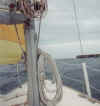


 No turning back now, though.
The day is gray, but the wind and waves agreeable.
As the western coast of Puerto Rico recedes from our stern wake,
we eventually catch a glimpse of Mona Island (
Ankiewicz studio photos).
Long and low.
Along the way, we receive a mammalian escort that is fascinating to watch.
As we get closer, we spot a
shipwreck (photo Copyright Kristen Ankiewicz 1995-2000)
just off the southeastern portion of the island.
We turn west and parallel the southern shore,
then north along the western flank until we spot the anchorage,
which is really more of a cove protected by a small reef.
We gingerly make our way inside (location (1) on the chart below),
feel about with dinghy, snorkel, and almost the keel for a good spot to drop the hook, and stow the boat.
No turning back now, though.
The day is gray, but the wind and waves agreeable.
As the western coast of Puerto Rico recedes from our stern wake,
we eventually catch a glimpse of Mona Island (
Ankiewicz studio photos).
Long and low.
Along the way, we receive a mammalian escort that is fascinating to watch.
As we get closer, we spot a
shipwreck (photo Copyright Kristen Ankiewicz 1995-2000)
just off the southeastern portion of the island.
We turn west and parallel the southern shore,
then north along the western flank until we spot the anchorage,
which is really more of a cove protected by a small reef.
We gingerly make our way inside (location (1) on the chart below),
feel about with dinghy, snorkel, and almost the keel for a good spot to drop the hook, and stow the boat.
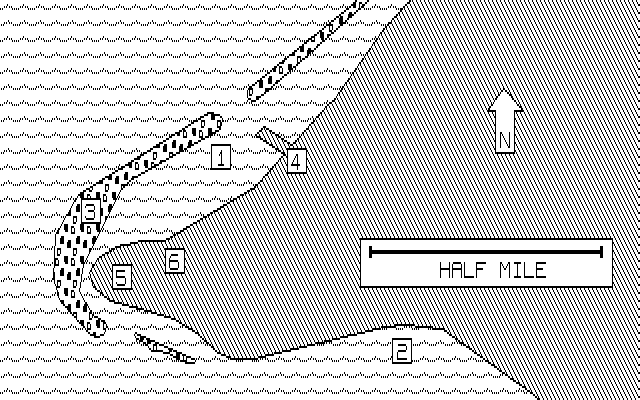
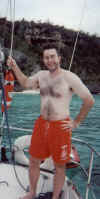
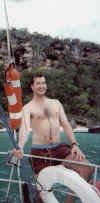
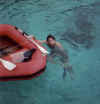
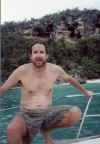 Once anchored, we pose for the obligatory photographs.
The anchorage is spectactular: the clear blue-green water that we expect but are never quite used to,
but also short cliffs in contrast to the sandy beaches that have been our companion to date.
Exploring is certainly in order.
Outside the reef, a decent sized (50-60 foot?) sport fishing boat anchors.
Fish may have been their target for the daylight hours,
but it becomes quickly obvious that their nighttime plans include music and drinking.
Now, our plans include music and drinking as well, and we don't even have to supply our own music.
Once anchored, we pose for the obligatory photographs.
The anchorage is spectactular: the clear blue-green water that we expect but are never quite used to,
but also short cliffs in contrast to the sandy beaches that have been our companion to date.
Exploring is certainly in order.
Outside the reef, a decent sized (50-60 foot?) sport fishing boat anchors.
Fish may have been their target for the daylight hours,
but it becomes quickly obvious that their nighttime plans include music and drinking.
Now, our plans include music and drinking as well, and we don't even have to supply our own music.

 Before heading in to explore the island, we do some snorkeling around the reef.
We learn several things.
First, no real need for SCUBA gear, although we have a rig on the boat "just in case."
Second, the water temperature and clarity reminds us of the near uselessness of snorkeling/SCUBA in New England.
Third, the opening in the reef through which we came can't be more than a boat-length or so--I can't imagine making
the passage in any kind of heavy seas or weather.
With respect to diving in New England,
I say "near usefulness," because I learned to dive in New England during graduate school.
Ten classes in the pool with instructor Steve Allen, who I recently learned is a fellow Waylander and with whom
I correspond by email from time to time on town matters--small world.
Then, a trip to Nahant in April for our first open water dive.
We sit next to a van with temperatures in the 50s and probably set world records for speed getting into
a wetsuit.
Our only saving grace is that we don't know any better--yet.
The surface temperature of the water is 44 degrees, 4 degrees warmer than the temperature at the bottom.
Two lessons come back to me.
One, the pleasure of peeing in a wetsuit far outweighs any realization that you probably aren't the first
to do so in one of the class wetsuits.
Second, it's time to get out when your lips are so numb that they can't hold the regulator in.
Before heading in to explore the island, we do some snorkeling around the reef.
We learn several things.
First, no real need for SCUBA gear, although we have a rig on the boat "just in case."
Second, the water temperature and clarity reminds us of the near uselessness of snorkeling/SCUBA in New England.
Third, the opening in the reef through which we came can't be more than a boat-length or so--I can't imagine making
the passage in any kind of heavy seas or weather.
With respect to diving in New England,
I say "near usefulness," because I learned to dive in New England during graduate school.
Ten classes in the pool with instructor Steve Allen, who I recently learned is a fellow Waylander and with whom
I correspond by email from time to time on town matters--small world.
Then, a trip to Nahant in April for our first open water dive.
We sit next to a van with temperatures in the 50s and probably set world records for speed getting into
a wetsuit.
Our only saving grace is that we don't know any better--yet.
The surface temperature of the water is 44 degrees, 4 degrees warmer than the temperature at the bottom.
Two lessons come back to me.
One, the pleasure of peeing in a wetsuit far outweighs any realization that you probably aren't the first
to do so in one of the class wetsuits.
Second, it's time to get out when your lips are so numb that they can't hold the regulator in.
 I make this digression because there was a time when the IBIS and SCUBA intersected.
I won't mention any names, but legend has it that a person closely associated with the IBIS was attempting to
set anchor off the swimming beach just south of the Padanaram Harbor entrance and the nearby radar dome.
Apparently, said person forgot the primary rule of anchoring, which is that it's not enough to tie the rhode to the
anchor, you must also tied the rhode to the boat.
The first splash was the anchor hitting the water.
The second splash was the other end of the line hitting the water.
The third splash was the spark in John's (oops, identity revealed) brain saying "grab."
The fourth splash was the person hitting the water.
The remaining inaudible splashes were the person's keys and treasured Swiss Army Knife dropping through the
water and heading for the bottom.
I don't recall the reason, but the person was able to roughly mark the location but unable to attempt any serious recover.
A week later, to do this person a favor, John and I went back to the spot with SCUBA gear and a prayer.
We found the approximate spot, decided on a rectangular "up and back" search pattern, and began.
Even though it was summer and the water was shallow (perhaps 10 feet),
temperature and air would not allow much more than an hour to search.
At about the 45 minute mark, eureka!--John had found both the keys and the knife.
Success, but not likely a career in marine salvage.
Enough of that--back to the islands.
I make this digression because there was a time when the IBIS and SCUBA intersected.
I won't mention any names, but legend has it that a person closely associated with the IBIS was attempting to
set anchor off the swimming beach just south of the Padanaram Harbor entrance and the nearby radar dome.
Apparently, said person forgot the primary rule of anchoring, which is that it's not enough to tie the rhode to the
anchor, you must also tied the rhode to the boat.
The first splash was the anchor hitting the water.
The second splash was the other end of the line hitting the water.
The third splash was the spark in John's (oops, identity revealed) brain saying "grab."
The fourth splash was the person hitting the water.
The remaining inaudible splashes were the person's keys and treasured Swiss Army Knife dropping through the
water and heading for the bottom.
I don't recall the reason, but the person was able to roughly mark the location but unable to attempt any serious recover.
A week later, to do this person a favor, John and I went back to the spot with SCUBA gear and a prayer.
We found the approximate spot, decided on a rectangular "up and back" search pattern, and began.
Even though it was summer and the water was shallow (perhaps 10 feet),
temperature and air would not allow much more than an hour to search.
At about the 45 minute mark, eureka!--John had found both the keys and the knife.
Success, but not likely a career in marine salvage.
Enough of that--back to the islands.



 We dinghy the short distance to shore, pulling up on a narrow sand beach next to a dilapidated concrete jetty
(location (4) on the chart).
We have two choices--left (north) towards caves, rocks, nooks, and crannies, or right towards signs of people.
We choose left.
One of my favorite photographs of the trip is the one above showing the IBIS at anchor,
apparently next to a rock formation of unknown size.
Actually, the formation is in the foreground and about the same size as our trusty vessel.
The next picture of John framed by the cave mouth gives a more realistic perspective.
We spend an hour or so abusing our bare feet on the rocks,
looking at various sea and almost-sea creatures (none looking edible even to the sushi eaters among us).
We dinghy the short distance to shore, pulling up on a narrow sand beach next to a dilapidated concrete jetty
(location (4) on the chart).
We have two choices--left (north) towards caves, rocks, nooks, and crannies, or right towards signs of people.
We choose left.
One of my favorite photographs of the trip is the one above showing the IBIS at anchor,
apparently next to a rock formation of unknown size.
Actually, the formation is in the foreground and about the same size as our trusty vessel.
The next picture of John framed by the cave mouth gives a more realistic perspective.
We spend an hour or so abusing our bare feet on the rocks,
looking at various sea and almost-sea creatures (none looking edible even to the sushi eaters among us).
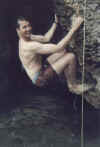
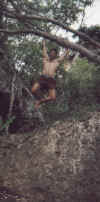
 We begin to make our way back to the south towards the jetty and perhaps people.
We have no idea what to expect--campsites, buildings, perhaps a store?
Campsites and buildings, yes, but we won't find a store or people.
First, Tony has some climbing to do.
Tony has climbing and in fact danger in general in his blood.
It is fortunate that Tony's guardian angel is a combination of a British SAS commando and Robin Williams--
supreme talent and a fantastically twisted sense of humor.
I won't begin to name the things that Tony has climbed or attempted to climb, as even my long list
won't do his resume justice.
One image I will relate is one that I've had related to me--a young (ten-year old?) Tony standing on the top of
a swingset during a thunder and lightning storm in Tulsa.
Everyone knows, of course, that superheroes are created when normal people (okay, so Tony has never been normal)
cross paths with abnormal happenings, such as radioactive spiders, exploding home planets, and yes, lightning.
The good news is that the lightning strike that knocked Tony from his (relatively low by his standards) perch didn't
kill him.
The bad news is that any super powers that he gained have failed to materialize (so he claims).
The pictures above show some of Tony's more modern handiwork.
Well, okay, the last of the three is actually a better illustration of his handishell and handibeer.
We begin to make our way back to the south towards the jetty and perhaps people.
We have no idea what to expect--campsites, buildings, perhaps a store?
Campsites and buildings, yes, but we won't find a store or people.
First, Tony has some climbing to do.
Tony has climbing and in fact danger in general in his blood.
It is fortunate that Tony's guardian angel is a combination of a British SAS commando and Robin Williams--
supreme talent and a fantastically twisted sense of humor.
I won't begin to name the things that Tony has climbed or attempted to climb, as even my long list
won't do his resume justice.
One image I will relate is one that I've had related to me--a young (ten-year old?) Tony standing on the top of
a swingset during a thunder and lightning storm in Tulsa.
Everyone knows, of course, that superheroes are created when normal people (okay, so Tony has never been normal)
cross paths with abnormal happenings, such as radioactive spiders, exploding home planets, and yes, lightning.
The good news is that the lightning strike that knocked Tony from his (relatively low by his standards) perch didn't
kill him.
The bad news is that any super powers that he gained have failed to materialize (so he claims).
The pictures above show some of Tony's more modern handiwork.
Well, okay, the last of the three is actually a better illustration of his handishell and handibeer.

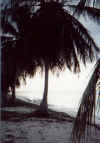
 Once south of the Jetty, we walked past the aforementioned signs of civilization.
(Some might argue that a vast solar array is actually a sign of not-civilization.)
Our path took us more or less towards a south facing beach near location (2) on the chart above.
Once south of the Jetty, we walked past the aforementioned signs of civilization.
(Some might argue that a vast solar array is actually a sign of not-civilization.)
Our path took us more or less towards a south facing beach near location (2) on the chart above.
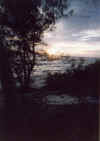


 Having found a beautiful sunset beach in the islands yet lacking women,
we did the only thing that men might do with their clothes on: gird for battle!
We easily sparred with the heavy quarterstaffs because either of (a) our supreme physical condition
(see: super powers, above) or (b) the fact that they were in reality hollowed out husks of their former log selves.
You be the judge.
Goodnight.
Having found a beautiful sunset beach in the islands yet lacking women,
we did the only thing that men might do with their clothes on: gird for battle!
We easily sparred with the heavy quarterstaffs because either of (a) our supreme physical condition
(see: super powers, above) or (b) the fact that they were in reality hollowed out husks of their former log selves.
You be the judge.
Goodnight.
|


 No turning back now, though.
The day is gray, but the wind and waves agreeable.
As the western coast of Puerto Rico recedes from our stern wake,
we eventually catch a glimpse of Mona Island (
No turning back now, though.
The day is gray, but the wind and waves agreeable.
As the western coast of Puerto Rico recedes from our stern wake,
we eventually catch a glimpse of Mona Island (






 I make this digression because there was a time when the IBIS and SCUBA intersected.
I won't mention any names, but legend has it that a person closely associated with the IBIS was attempting to
set anchor off the swimming beach just south of the Padanaram Harbor entrance and the nearby radar dome.
Apparently, said person forgot the primary rule of anchoring, which is that it's not enough to tie the rhode to the
anchor, you must also tied the rhode to the boat.
The first splash was the anchor hitting the water.
The second splash was the other end of the line hitting the water.
The third splash was the spark in John's (oops, identity revealed) brain saying "grab."
The fourth splash was the person hitting the water.
The remaining inaudible splashes were the person's keys and treasured Swiss Army Knife dropping through the
water and heading for the bottom.
I don't recall the reason, but the person was able to roughly mark the location but unable to attempt any serious recover.
A week later, to do this person a favor, John and I went back to the spot with SCUBA gear and a prayer.
We found the approximate spot, decided on a rectangular "up and back" search pattern, and began.
Even though it was summer and the water was shallow (perhaps 10 feet),
temperature and air would not allow much more than an hour to search.
At about the 45 minute mark, eureka!--John had found both the keys and the knife.
Success, but not likely a career in marine salvage.
Enough of that--back to the islands.
I make this digression because there was a time when the IBIS and SCUBA intersected.
I won't mention any names, but legend has it that a person closely associated with the IBIS was attempting to
set anchor off the swimming beach just south of the Padanaram Harbor entrance and the nearby radar dome.
Apparently, said person forgot the primary rule of anchoring, which is that it's not enough to tie the rhode to the
anchor, you must also tied the rhode to the boat.
The first splash was the anchor hitting the water.
The second splash was the other end of the line hitting the water.
The third splash was the spark in John's (oops, identity revealed) brain saying "grab."
The fourth splash was the person hitting the water.
The remaining inaudible splashes were the person's keys and treasured Swiss Army Knife dropping through the
water and heading for the bottom.
I don't recall the reason, but the person was able to roughly mark the location but unable to attempt any serious recover.
A week later, to do this person a favor, John and I went back to the spot with SCUBA gear and a prayer.
We found the approximate spot, decided on a rectangular "up and back" search pattern, and began.
Even though it was summer and the water was shallow (perhaps 10 feet),
temperature and air would not allow much more than an hour to search.
At about the 45 minute mark, eureka!--John had found both the keys and the knife.
Success, but not likely a career in marine salvage.
Enough of that--back to the islands.











